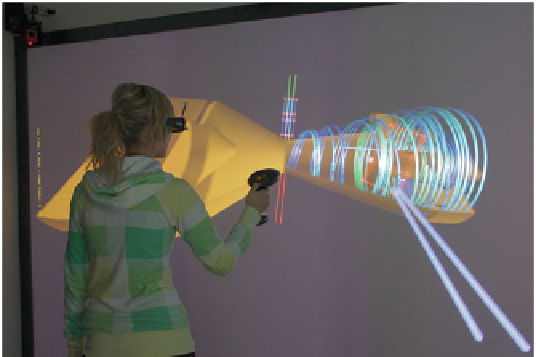Image Processing Reference
In-Depth Information
Fig. 31.1
Interactive flow field exploration of a centrifuge in a virtual environment
resulting simulation output can exceed sizes of tera- and peta-bytes of data. Without
appropriate approaches for the analyses of those datasets, it is almost impossible to
obtain better insight into the highly complex interdependencies of dynamic systems.
Often, merely some samples are taken or simplified views are generated just to proof
the correctness of the hypothesis used for the modeling.
In case that such simplified confirmative approach is not sufficient and satisfying
enough, more explorative methods have to be integrated into the workflow. Explo-
ration, however, requires interactive tools to enable the search for findings which
were unexpected or not known yet. Interactivity on large-scale datasets is the main
challenge of a real-time post-processing of dynamic simulations. Furthermore, pro-
duced results typically consist of many scalar and higher-dimensional data fields
and may also change over time. One of the most intuitive ways to facilitate insight
into those data is scientific visualization. Improved virtual reality (VR) techniques
can eventually add the demanded interactivity in order to achieve an immersive and
intuitive exploration environment (see Fig.
31.1
).
Precise tracking of the scientist in a virtual environment and updating the view-
dependent images on (typically) multiple displays with high frame rates is already
a challenging requirement on such systems. Therefore, handling of large-scale sim-
ulation data and performing an appropriate post-processing on the same machine
would easily break the interactivity requirements required for such explorative visu-
alization environments. The solution is a distributed architecture, which relieves the
visualization frontend from heavy post-processing work that can now be moved to a
remote system. In addition, the visualization can be performed by remote rendering
clusters to enhance the interactivity at the frontend even more.
With a supercomputer at hand, the post-processing can additionally be sped-up
considerably by parallelization strategies. Instead of storing results of a running sim-
ulation to the file server, it may now also be possible to process the data directly

Search WWH ::

Custom Search